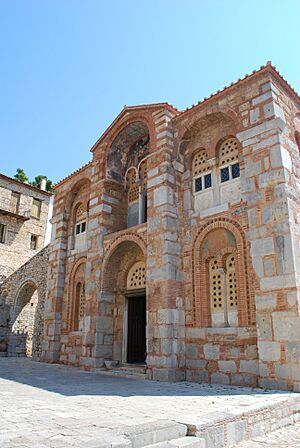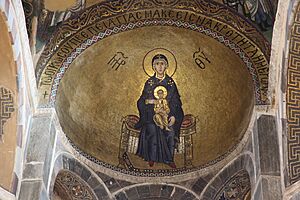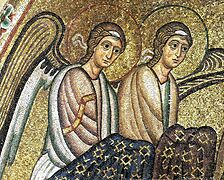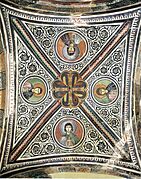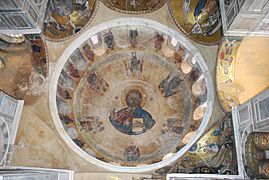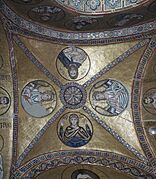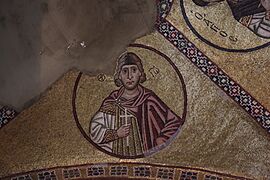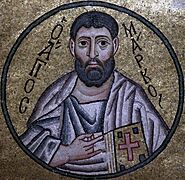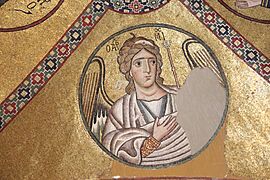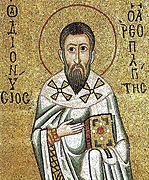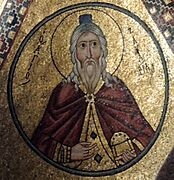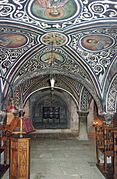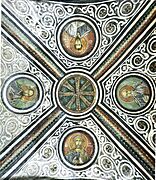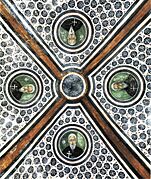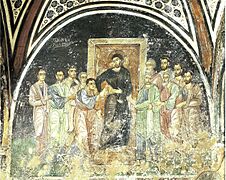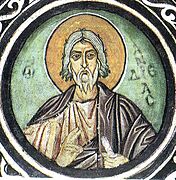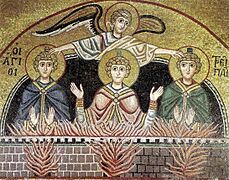Hosios Loukas facts for kids
| UNESCO World Heritage Site | |
|---|---|
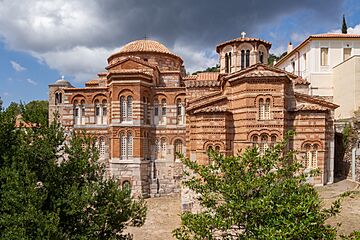 |
|
| Location | Distomo-Arachova-Antikyra Municipality, Boeotia, Central Greece, Greece |
| Part of | Monasteries of Daphni, Hosios Loukas and Nea Moni of Chios |
| Criteria | Cultural: (i)(iv) |
| Inscription | 1990 (14th Session) |
| Area | 1.43 ha (3.5 acres) |
| Buffer zone | 5,443.31 ha (13,450.7 acres) |
Hosios Loukas (Greek: Ὅσιος Λουκᾶς) is a very old monastery in Greece. It is surrounded by walls and is located near the town of Distomo, in a region called Boeotia. This monastery was built in the middle of the 10th century. It is one of the most important examples of Middle Byzantine architecture and art. Since 1990, it has been recognized as a UNESCO World Heritage Site. It shares this honor with two other famous monasteries: Nea Moni and Daphnion.
Contents
History of the Monastery
The Hosios Loukas monastery is built in a beautiful spot on the side of Mount Helicon. It was started in the early 900s by a hermit named Luke of Steiris. A hermit is someone who lives alone, often for religious reasons. His holy remains are still kept at the monastery today.
Saint Luke's Life and Prophecies
Saint Luke, who passed away on February 7, 953, was known for predicting that Emperor Romanos would conquer the island of Crete. At first, people thought he meant Emperor Romanos I. However, Crete was actually taken back by Nicephorus Phocas when Romanos II was emperor. It is believed that the monastery's first church, dedicated to the Theotokos (which means "Mother of God" or Panagia), was built during Emperor Romanos II's rule (959-963).
The Tomb and Miracles
The most important part of the monastery is the tomb of Saint Luke. It was originally in a hidden room but was later moved to where the two main churches meet. The monastery became wealthy because people believed that Saint Luke's remains produced a special perfumed oil called myron. This oil was said to cause healing miracles. Pilgrims, or religious travelers, would often sleep near the tomb. They hoped to be healed through a practice called incubation, which involved sleeping in a holy place to receive a divine message or healing. The beautiful mosaics around the tomb show Saint Luke himself. They also show the abbot (leader of the monastery) Philotheos, presenting a model of the new church to the saint.
Later Years
A local shepherd named Nicholas the Pilgrim lived at the monastery for a while in the late 1000s. However, he was asked to leave because of his unusual behavior. Later, in 1206, during the time of the Latin Empire, a church official named Benedict of Porto gave Hosios Loukas to a group of religious canons.
Architecture of Hosios Loukas
The Churches
The oldest church in the monastery complex is called Hosios Loukas. It is the only church in mainland Greece that we know for sure was built in the 10th century. This church has a unique shape, like a centralized rectangle. It is the earliest example in Greece of a "cross-in-square" church design. Its layout is very similar to the Lips Monastery in Constantinople. The walls are made from a mix of brick, stone, and marble, called opus mixtum. They also have interesting patterns that look like pseudo-kufic writing.
Next to the Hosios Loukas church is a larger main church called the Katholikon. This church was likely built around 1011-1012. The Katholikon is the earliest church still standing that has a "domed-octagon" design. This means it has eight pillars arranged around the central part of the church, called the naos (or nave). The dome, which is shaped like half a sphere, sits on four special supports called squinches. These squinches help connect the octagonal base under the dome to the square walls below. The main part of the church is surrounded by walkways and smaller chapels on all four sides.
Beautiful Decorations
Hosios Loukas is the largest of three important monasteries from the Middle Byzantine period in Greece. It is special because it is dedicated to a single military saint. Saint Luke's prediction about taking back Crete is remembered by a picture of Joshua on the outside wall of the Panagia church. Joshua was seen as a great "warrior of faith," whose help was especially useful in wars against the Arabs.
The Katholikon church has some of the best-preserved mosaics from the time known as the Macedonian Renaissance. However, some parts of the decoration are missing. For example, the original image of Christ Pantocrator (Christ as "Ruler of All") inside the dome is gone. Also, the figures of archangels that were usually placed between the upper windows are no longer there.
There is evidence that this monastery was famous throughout the Byzantine Empire for its rich decorations. These included beautiful marble coverings, carvings, gold and silver plates, murals (wall paintings), and mosaics. The mosaics were especially impressive on curved surfaces. The inside of the church also had a wonderful collection of icons (religious images), chandeliers, silk curtains, and altar cloths. Only a few of these items are still in their original places, like the colored marble walls and window grilles. Even with these losses, the Katholikon still gives us the best idea of what a church interior looked like in the centuries after the end of Iconoclasm. Iconoclasm was a period when religious images were destroyed.
The Burial Crypt
Beneath the large domed Katholikon church is a hidden burial crypt. You can only reach it by a staircase on the south side.
The crypt has three main areas: the entrance, the main inner space with nine arched sections, and a special area for religious services with an apse (a curved end). There are also three arched passages, which were once used as places to store bones.
For hundreds of years, the frescoes (wall paintings) in the crypt were covered in dust and hidden. But in the 1960s, the Greek Archaeological Service cleaned the crypt. They found that the frescoes were remarkably well preserved! Only the apse had lost most of its plaster, showing the bricks and stones underneath. The entrance and some arched sections had slight damage from water and minor vandalism, mostly on the lower parts of the walls near the entrance.
The crypt has frescoes in its entryway and on its ceiling. There are eight arched sections around the walls that show scenes from Christ’s Passion (his suffering and death) and Resurrection (his rising from the dead). There are also forty round portraits of apostles, martyrs, and holy men, including abbots like Philotheos. Many inscriptions are also present. One expert, C.L. Connor, says it has "the most complete programme of wall paintings surviving from the Middle Byzantine period."
It is believed that most, if not all, of the crypt frescoes were painted after 1048 AD. This was after the death of Theodore Leobachus, a wealthy government official who was likely one of the main supporters of the monastery. He later became the abbot of Hosios Loukas.
The special area for religious services in the crypt has a niche for offerings, an altar, and a barrier. These show that the Eucharist (a Christian ceremony) was probably celebrated here. This would have been part of burial services, remembering important religious figures, or ceremonies related to the healing power of Saint Luke.
When pilgrims or people seeking healing from Saint Luke visited Hosios Loukas, they would sleep not only in the Katholikon but also in the crypt itself. This is where Saint Luke's tomb was kept, along with two others believed to be abbots. During his life, Saint Luke was believed to be a miraculous healer, someone who could float in the air, miraculously feed people, and predict the future. After his death, all the miracles linked to him involved the healing power of his tomb. Connor mentions that stories in The Vita of St. Luke, written by an anonymous monk, say that "healing agents" connected to the tomb included oil from the lamp above it, moisture from the tomb, and dreams experienced while sleeping near the tomb (the practice of incubation). People visited the tomb before and after the monastery was finished. After its completion, it became the main focus of the miracle cult of Saint Luke. There is evidence that some people hoping for miracles stayed for up to six days near the tomb or in nearby rooms.
Gallery
- Hosios Loukas
See also
- Macedonian art (Byzantine)
- History of Roman and Byzantine domes


